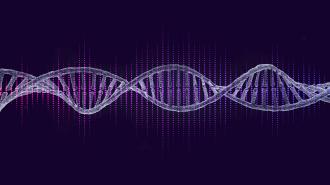Scientists have created the world’s smallest antenna, measuring only five nanometers in length, out of synthetic DNA.
But it doesn’t transmit radio waves — instead, this little antenna is designed to signal real-time changes in proteins. And because it’s fluorescent, it records and transmits data via light signals.
“Chemists have realized that DNA can also be employed to build a variety of nanostructures and nanomachines.”
Alexis Vallée-Bélisle
How it works: The nanoantenna is constructed of DNA molecules, the genetic instructions for life, which are 20,000 times smaller than a human hair.
Everything works on a scale smaller than the human eye can see. The receiver component of this antenna feels the molecular surface of the protein it’s investigating. When the protein performs its biological purpose, it produces a unique signal, reports Science Alert.
Chemist Alexis Vallée-Bélisle, the lead author on the study published in Nature Methods, explained how the nanoantenna works using a two-way radio analogy. It can send and receive signals in a wavelength (or color) of light. The antenna first receives light in one color. Then, depending on the activity it detects from the protein, it sends light back in another color.
Why this matters: Fluorescent nanoantennas, according to the researchers, bring up a slew of new possibilities in biology and nanotechnology.
Scott Harroun is a University of Montreal doctoral student in chemistry and one of the study’s authors. He described how they were able to monitor the response of a particular enzyme to a range of medications.
The enzyme (called alkaline phosphatase) is linked to various illnesses, like cancer and intestinal inflammation. Seeing it react in real-time to these substances and drugs could help chemists identify and develop new drugs.
“Perhaps what we are most excited by is the realization that many labs around the world, equipped with a conventional spectrofluorometer, could readily employ these nanoantennas to study their favorite protein, such as to identify new drugs or to develop new nanotechnologies,” Vallée-Bélisle said in a statement.
Future: This isn’t the first time scientists used DNA to create a nanostructure. It is gaining interest as a component for tiny technology, like in data storage because it is stable and relatively easy to program.
“In recent years, chemists have realized that DNA can also be employed to build a variety of nanostructures and nanomachines,” Vallée-Bélisle said.
According to Vallée-Bélisle, the team plans to establish a start-up to commercialize the nanoantenna so other pharmaceutical researchers can use it.
This article has been updated to correctly state that synthetic DNA was used in this study.
We’d love to hear from you! If you have a comment about this article or if you have a tip for a future Freethink story, please email us at [email protected].






